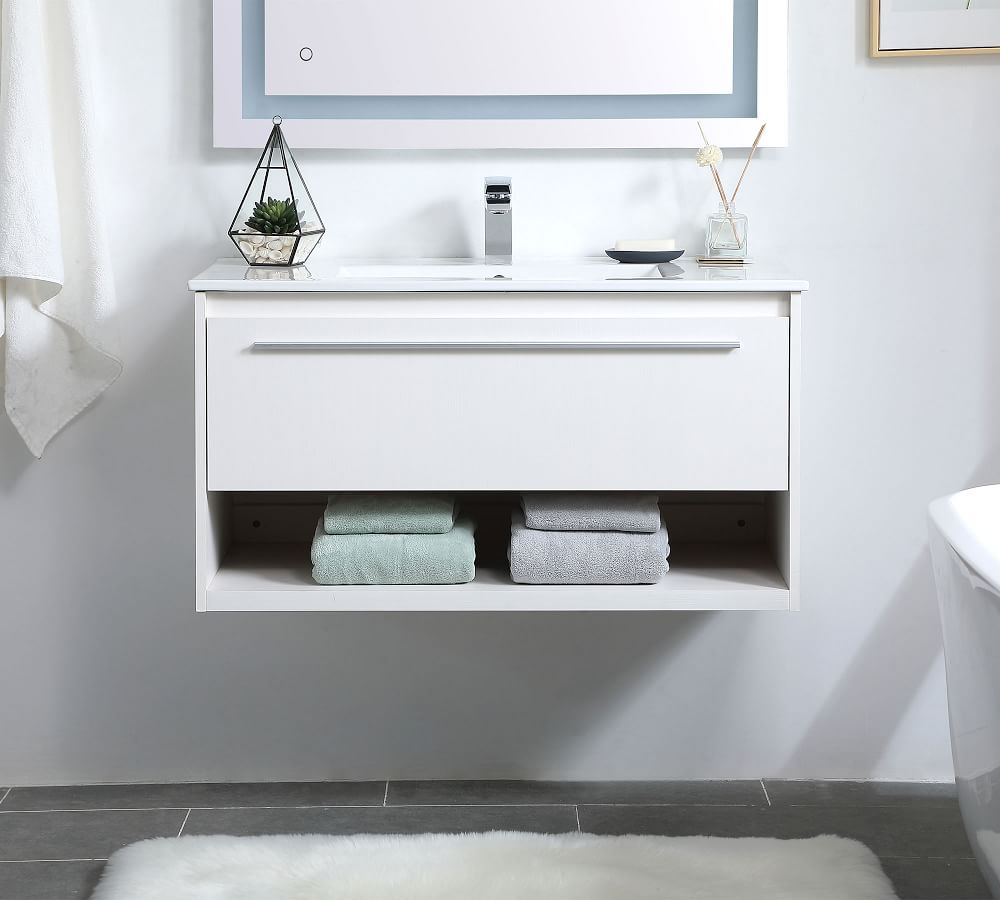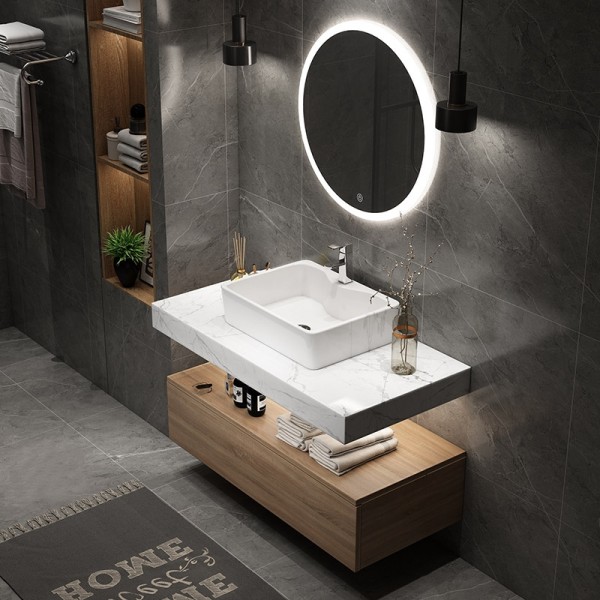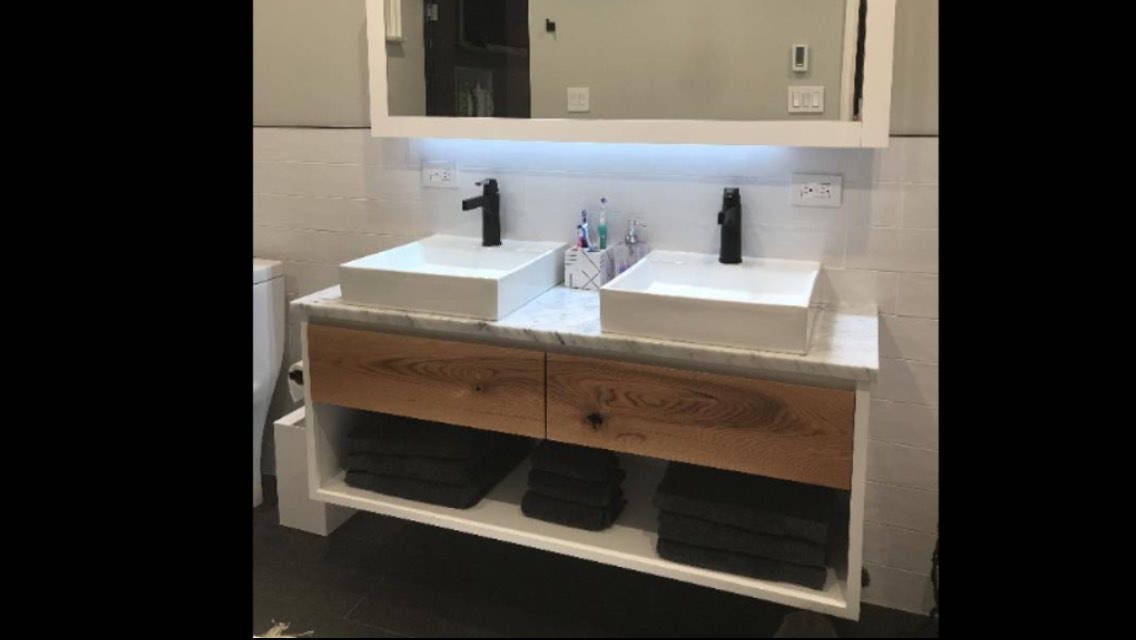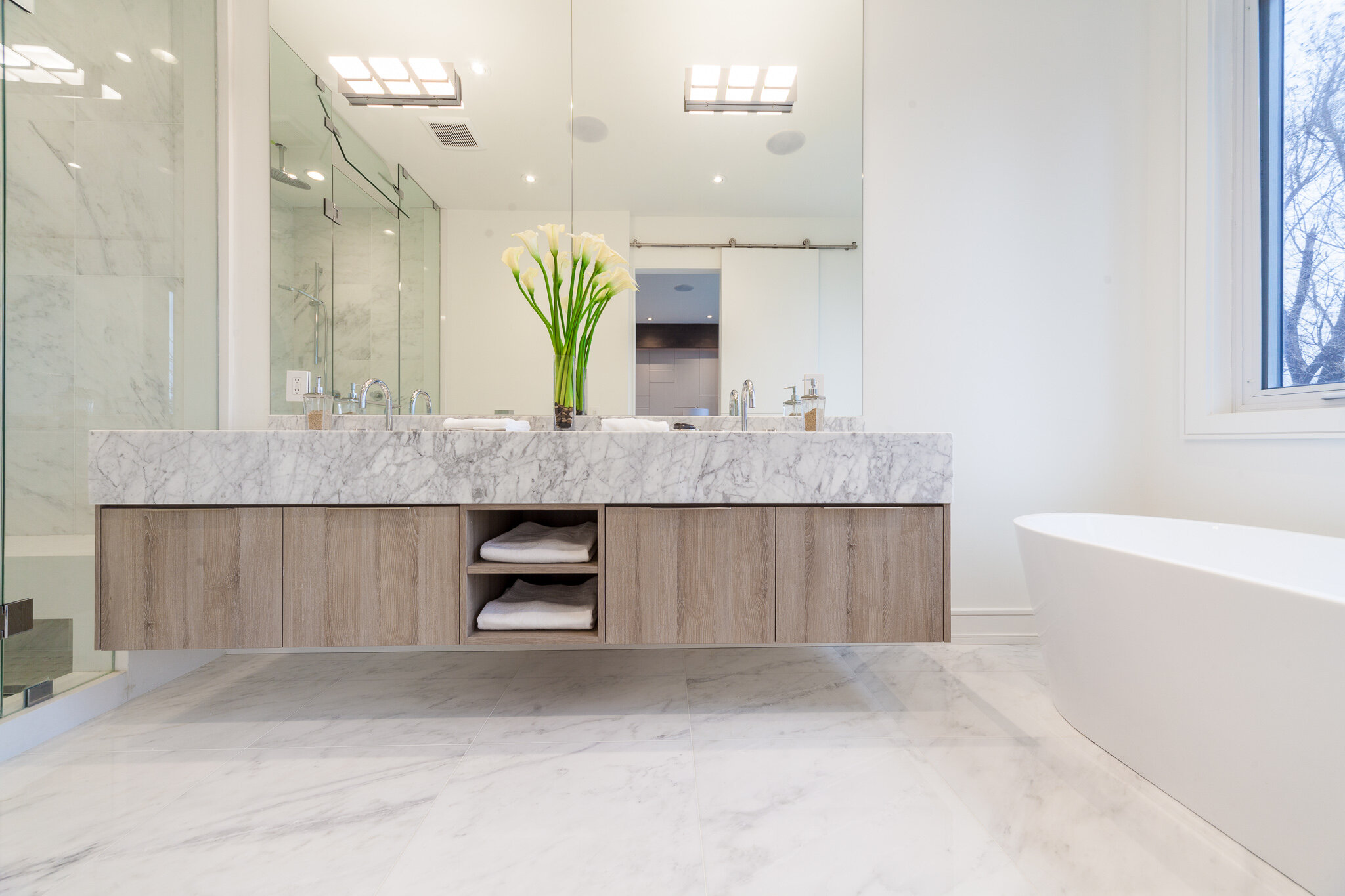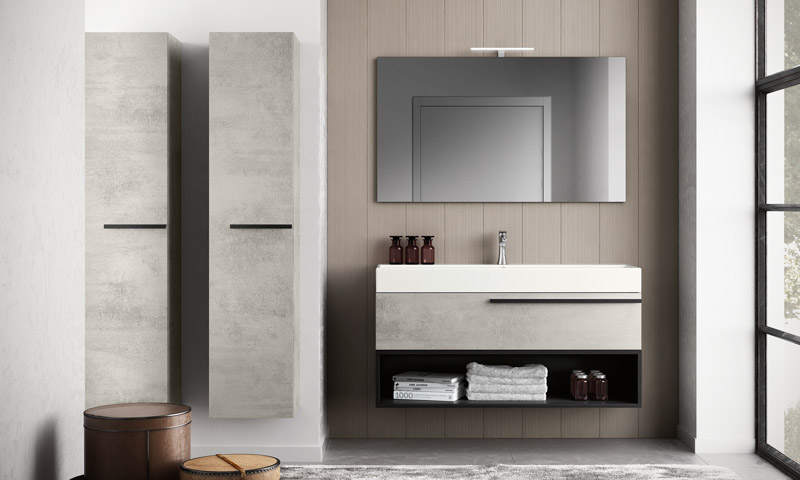The Rise of Modern Floating Bathroom Vanities
When I first heard about floating bathroom vanities, I was intrigued by the concept. These sleek, wall-mounted fixtures have become a staple in contemporary bathroom design. The rise of modern floating bathroom vanities can be attributed to their minimalist appeal, space-saving benefits, and the way they effortlessly blend with various decor styles.
- Historical Perspective Floating vanities didn’t just appear overnight. They are the product of a design evolution aimed at maximizing functionality while minimizing clutter. Traditional vanities often dominated the bathroom space, leaving little room for creativity. With the advent of floating vanities, this changed dramatically. Their clean lines and unobtrusive presence make them a favorite among modern homeowners and designers alike.
- Influence of Modern Design Trends The shift towards minimalism and modernism in interior design has significantly influenced the popularity of floating vanities. As more people embraced the ‘less is more’ philosophy, these vanities became a perfect fit for contemporary homes. They provide a streamlined look that complements other modern fixtures, creating a cohesive and visually appealing bathroom space.
- Functionality Meets Style One of the main reasons floating vanities have become so popular is their ability to marry functionality with style. They offer ample storage without the bulkiness of traditional vanities. This blend of practicality and aesthetics is particularly appealing to those of us who want our bathrooms to be both beautiful and functional.
- Space-Saving Benefits Floating vanities are particularly beneficial in small bathrooms. By mounting the vanity on the wall, the floor space underneath is freed up, making the room appear larger and more open. This is a game-changer for those of us dealing with compact living spaces, where every inch counts.
- Versatility in Design The versatility of floating vanities is another reason for their rise. They come in a variety of styles, materials, and finishes, allowing homeowners to customize their bathroom to their taste. Whether you prefer a sleek, modern look or a more rustic, natural aesthetic, there’s a floating vanity out there for you.
- Future of Bathroom Design As we look to the future of bathroom design, it’s clear that floating vanities will continue to play a significant role. Their combination of style, functionality, and space-saving benefits make them a timeless addition to any modern home. I’m excited to see how designers will continue to innovate and incorporate these versatile fixtures into their projects.

Design Elegance: The Aesthetic Appeal of Floating Vanities
When it comes to bathroom design, elegance is key. Floating vanities have taken center stage in this regard, offering a sophisticated and stylish solution that elevates the overall look of any bathroom. Let me share with you why these vanities are so aesthetically appealing and how they can transform your space.
Clean Lines and Minimalist Design The first thing that strikes me about floating vanities is their clean lines and minimalist design. Unlike traditional vanities, which can be bulky and overpowering, floating vanities provide a sleek and streamlined appearance. This simplicity is visually appealing and creates a sense of calm and order in the bathroom.
Illusion of Space One of the most significant advantages of floating vanities is their ability to create the illusion of more space. By being mounted on the wall, they free up floor space, making the room feel larger and more open. This is particularly beneficial in smaller bathrooms, where space is at a premium. The open area beneath the vanity can be used for additional storage or simply left empty to enhance the airy feel.
Variety of Materials and Finishes Floating vanities come in a wide range of materials and finishes, allowing you to customize your bathroom to your exact preferences. From natural wood to sleek glass, there’s a material to suit every style. I personally love the look of a glossy white finish for a modern, clean aesthetic, but rustic wood can also add warmth and character to the space.
Integration with Modern Fixtures These vanities seamlessly integrate with other modern bathroom fixtures, creating a cohesive and harmonious design. Whether paired with a chic vessel sink or a contemporary faucet, floating vanities enhance the overall look of the bathroom. The key is to choose fixtures that complement the vanity’s design, creating a unified and elegant appearance.
Highlighting Floor and Wall Tiles One often overlooked benefit of floating vanities is their ability to showcase beautiful floor and wall tiles. Since the vanity doesn’t extend to the floor, it allows the tiles to take center stage. This can be particularly effective with intricate or bold tile patterns, turning the bathroom into a true work of art.
Personal Expression Ultimately, the aesthetic appeal of floating vanities lies in their ability to reflect your personal style. Whether you prefer a minimalist look, a rustic charm, or a luxurious feel, there’s a floating vanity that fits your vision. I love how these vanities can be both a functional piece and a statement of personal taste, transforming a simple bathroom into a stylish retreat.
Space Efficiency: Maximizing Bathroom Space with Floating Vanities
In my quest to make the most of every square inch in my home, I’ve discovered that floating bathroom vanities are a fantastic solution for maximizing space. These modern fixtures are not only stylish but also incredibly efficient when it comes to utilizing limited bathroom space. Here’s how floating vanities can help you achieve a more spacious and organized bathroom.
Freeing Up Floor Space One of the most obvious benefits of floating vanities is the way they free up floor space. By mounting the vanity on the wall, the floor beneath is left open, which can make a small bathroom feel much larger. This open space can be used for additional storage solutions or simply left clear to enhance the sense of roominess.
Creating a Sense of Openness The open space beneath a floating vanity isn’t just practical; it also contributes to a more open and airy feel in the bathroom. Without a bulky vanity taking up floor space, the room appears less cluttered and more inviting. This sense of openness can make even the smallest bathroom feel more comfortable and luxurious.
Smart Storage Solutions Floating vanities often come with clever storage options that help keep the bathroom organized. Drawers and cabinets can be designed to hold toiletries, cleaning supplies, and other essentials without taking up additional space. Some models even feature hidden compartments for a sleeker, more streamlined look. This smart storage can be a game-changer for those of us who struggle with cluttered countertops and overflowing cabinets.
Customization and Flexibility One of the things I love most about floating vanities is their customization options. Because they don’t have to sit on the floor, you can choose the height that works best for you. This flexibility can be particularly useful in accommodating different family members’ needs or creating a more accessible bathroom for those with mobility issues.
Enhanced Cleaning and Maintenance Cleaning a bathroom with a floating vanity is much easier than with a traditional vanity. The open space beneath allows for easy access to the floor, making it simpler to sweep and mop. This can be a significant time-saver, especially in busy households where keeping the bathroom clean is a constant battle.
Versatile Design Options Floating vanities are available in a wide range of designs, materials, and finishes, making it easy to find one that fits your bathroom’s style and your space-saving needs. Whether you prefer a sleek, modern look or a more traditional aesthetic, there’s a floating vanity that can help you maximize your bathroom space while adding a touch of elegance.
Installation Insights: How to Properly Install a Floating Vanity
Installing a floating vanity can seem like a daunting task, but with the right guidance, it can be a straightforward and rewarding project. When I decided to install a floating vanity in my bathroom, I discovered several key steps and tips that made the process much smoother. Here’s a detailed guide to help you install your floating vanity properly.
Planning and Preparation Before you begin, it’s essential to plan and prepare. Measure the space where you want to install the vanity to ensure it will fit correctly. Consider the height at which you want the vanity to be mounted, keeping in mind the comfort and accessibility of all users. Gather all the necessary tools and materials, including a stud finder, level, drill, screws, and mounting brackets.
Locating the Studs Finding the wall studs is a crucial step in installing a floating vanity. Use a stud finder to locate the studs in the wall where you plan to mount the vanity. Mark their positions with a pencil. Studs provide the necessary support for the vanity, ensuring it is securely attached to the wall. If the studs don’t align with the mounting points of your vanity, you may need to install a mounting plate for added support.
Mounting the Brackets Once you’ve located the studs, the next step is to mount the brackets. Use a level to ensure the brackets are perfectly horizontal. This is crucial for the vanity to sit evenly and look professional. Drill pilot holes into the studs and then attach the brackets using appropriate screws. Make sure the brackets are securely fastened to support the weight of the vanity and any items placed on it.
Attaching the Vanity With the brackets securely in place, it’s time to attach the vanity. Carefully lift the vanity and align it with the mounting brackets. Depending on the design of your vanity, you may need a helper to hold it in place while you secure it. Attach the vanity to the brackets using screws, ensuring it is firmly fixed and level. Double-check that the vanity is securely attached and doesn’t wobble.
Plumbing and Fixtures After the vanity is mounted, the next step is to connect the plumbing and fixtures. This may involve attaching the sink, faucet, and drain pipes. Make sure all connections are tight and leak-free. If you’re not comfortable with plumbing tasks, it’s a good idea to hire a professional to ensure everything is installed correctly and to avoid any potential water damage.
Finishing Touches Once the vanity and plumbing are installed, it’s time for the finishing touches. Seal any gaps between the vanity and the wall with caulk to prevent water from seeping behind the vanity. Install any additional accessories, such as towel bars or mirrors, to complete the look. Finally, step back and admire your new floating vanity, knowing that you successfully installed it yourself.
Material Choices: Best Materials for Modern Floating Vanities
Choosing the right material for your floating vanity is crucial for both its appearance and durability. When I was selecting a floating vanity for my bathroom, I explored various materials to find the perfect balance between style and functionality. Here are some of the best materials for modern floating vanities and their unique benefits.
Solid Wood Solid wood is a timeless choice for bathroom vanities. It offers a natural and warm aesthetic that can complement various design styles. Hardwoods like oak, walnut, and teak are particularly durable and resistant to moisture, making them ideal for bathroom environments. I love the rich texture and grain patterns of solid wood, which add character and elegance to any bathroom.
MDF (Medium-Density Fiberboard) MDF is a popular choice for modern floating vanities due to its affordability and versatility. It’s made from compressed wood fibers and resin, resulting in a smooth and uniform surface that’s easy to paint or veneer. MDF is less prone to warping than solid wood, making it a practical option for bathrooms with high humidity. I appreciate the clean and sleek look of MDF vanities, especially when finished with a glossy paint or laminate.
Plywood Plywood is another excellent material for floating vanities. It’s made by layering thin sheets of wood veneer, resulting in a strong and stable product. Plywood is more resistant to moisture than MDF and can be finished with various veneers or laminates to achieve different looks. I find plywood to be a great compromise between the durability of solid wood and the affordability of MDF.
Glass For a truly modern and sophisticated look, glass vanities are a fantastic option. Tempered glass is durable and resistant to heat and moisture, making it suitable for bathroom use. Glass vanities can create a sleek and airy feel, especially when paired with minimalist fixtures. I love the way light reflects off glass surfaces, adding a touch of elegance and brightness to the bathroom.
Metal Metal vanities, particularly those made from stainless steel or aluminum, offer a contemporary and industrial aesthetic. These materials are highly durable, resistant to moisture, and easy to clean. Metal vanities can add a bold and unique touch to the bathroom, especially when combined with other modern elements. I appreciate the durability and low-maintenance nature of metal vanities, which are perfect for busy households.
Engineered Stone Engineered stone, such as quartz or marble composites, is a popular choice for vanity countertops. These materials offer the luxurious look of natural stone but with enhanced durability and resistance to stains and scratches. Engineered stone countertops are available in a wide range of colors and patterns, allowing for customization to suit any design preference. I love the elegance and durability of engineered stone, which can elevate the overall look of the bathroom.
Maintenance Tips: Keeping Your Floating Vanity Pristine
Maintaining the pristine condition of a floating vanity can seem challenging, but with the right approach, it’s quite manageable. When I installed my floating vanity, I quickly learned the importance of regular care and maintenance to keep it looking its best. Here are some effective tips to help you maintain your floating vanity.
Regular Cleaning Regular cleaning is essential to prevent the buildup of dirt, grime, and soap scum on your vanity. Use a soft cloth or sponge with a mild, non-abrasive cleaner to wipe down the surfaces. Avoid harsh chemicals or abrasive pads, as they can damage the finish. For glass vanities, a glass cleaner can be used to maintain a streak-free shine. I find that cleaning my vanity weekly helps keep it looking fresh and new.
Protecting the Finish Protecting the finish of your vanity is crucial for its longevity. If you have a wood or MDF vanity, consider applying a protective sealant to guard against moisture and stains. Be cautious with products like hair dyes, nail polish, and harsh cleaning agents, as they can cause permanent damage to the surface. I always use coasters or trays to keep such items from directly contacting the vanity surface.
Addressing Water Damage Water damage is a common issue in bathrooms, especially around the sink area. To prevent water damage, promptly wipe up any water spills or splashes. Ensure that the caulking around the sink and countertop is intact and replace it if necessary. If you notice any signs of water damage, such as warping or discoloration, address the issue immediately to prevent further damage. I make it a habit to check for leaks and water damage regularly.
Organizing and Decluttering Keeping your vanity organized and clutter-free not only enhances its appearance but also makes cleaning easier. Use drawer organizers, baskets, and trays to keep toiletries and other items neatly arranged. Avoid overcrowding the vanity surface, as this can lead to scratches and stains. I find that a well-organized vanity not only looks better but also makes my daily routine more efficient.
Routine Inspections Regularly inspect your floating vanity for any signs of wear and tear. Check the mounting brackets and screws to ensure they are secure and not loosening over time. Look for any signs of damage to the finish, hardware, or plumbing connections. Addressing minor issues promptly can prevent more significant problems down the line. I schedule a quick inspection of my vanity every few months to catch any potential issues early.
Polishing and Refinishing Depending on the material of your vanity, occasional polishing or refinishing may be necessary to maintain its appearance. Wood vanities can benefit from periodic polishing with a suitable wood polish to enhance their shine and protect the finish. For metal or glass vanities, a gentle polishing with the appropriate cleaner can help maintain their luster. I love how a little bit of polishing can make my vanity look brand new.
Tips for Selecting the Perfect Floating Vanity for Your Bathroom
Selecting the perfect floating vanity for your bathroom can be an exciting yet daunting task. When I went through this process, I discovered several key factors to consider to ensure I made the right choice. Here are some tips to help you select the ideal floating vanity for your bathroom.
Assess Your Space Before you start shopping, take precise measurements of your bathroom space. Consider the available wall space, the height at which you want the vanity mounted, and the depth that will work best without obstructing movement. Having accurate measurements will help you narrow down your options and choose a vanity that fits perfectly. I found that measuring twice saved me from potential sizing mistakes.
Determine Your Style Think about the overall style and aesthetic of your bathroom. Do you prefer a modern, minimalist look or something more traditional and ornate? Floating vanities come in various designs, materials, and finishes, so choose one that complements your bathroom’s decor. I spent some time browsing design inspirations to get a clear idea of the style I wanted.
Consider Storage Needs Evaluate your storage needs to determine the type of vanity that will work best for you. If you need ample storage space, look for vanities with multiple drawers and cabinets. If you prefer a minimalist look, opt for a vanity with sleek, hidden storage options. I made a list of the items I needed to store in the vanity to help me choose one with adequate storage solutions.
Choose the Right Material The material of your floating vanity plays a significant role in its durability and appearance. Consider factors like moisture resistance, ease of maintenance, and aesthetic appeal when selecting the material. Whether you opt for solid wood, MDF, glass, metal, or engineered stone, make sure it aligns with your bathroom’s needs and your personal style. I spent time researching the pros and cons of different materials before making my decision.
Pay Attention to Installation Requirements Installing a floating vanity requires proper support and secure mounting. Ensure that the wall where you plan to install the vanity can support its weight. If you’re not confident in your DIY skills, consider hiring a professional to handle the installation. Knowing the installation requirements helped me avoid potential issues and ensured a safe and secure installation.
Budget Considerations Floating vanities come in a wide range of price points, so it’s essential to establish a budget before you start shopping. Consider the cost of the vanity itself, as well as any additional expenses for installation, plumbing, and accessories. I found that setting a budget helped me focus on options within my price range and prevented me from overspending.
Evanna 24-40″ Single Sink Floating Vanity
Modern 36″/40″ Floating Wall Mount Single Bathroom Vanity Set with Faux Mable Top
Floating Bathroom Vanity Modern Bathroom Vanity Rustic
Custom Modern Floating Bathroom Vanity
Floating Bathroom Vanities – Matrix European Cabinets
Related Posts:
- Bathroom Vanity With Vessel Sink Mount
- Where To Buy Bathroom Vanity Mirrors
- Bathroom Vanity Linen Cabinet
- Narrow Width Bathroom Vanity
- Bathroom Vanity Height 36 Inch
- Discount Bathroom Vanity Mirrors
- Custom Bathroom Vanity Cabinets
- 4 Light Bathroom Vanity Lights
- Height Of Bathroom Vanity Unit
- Bathroom Vanity Globes
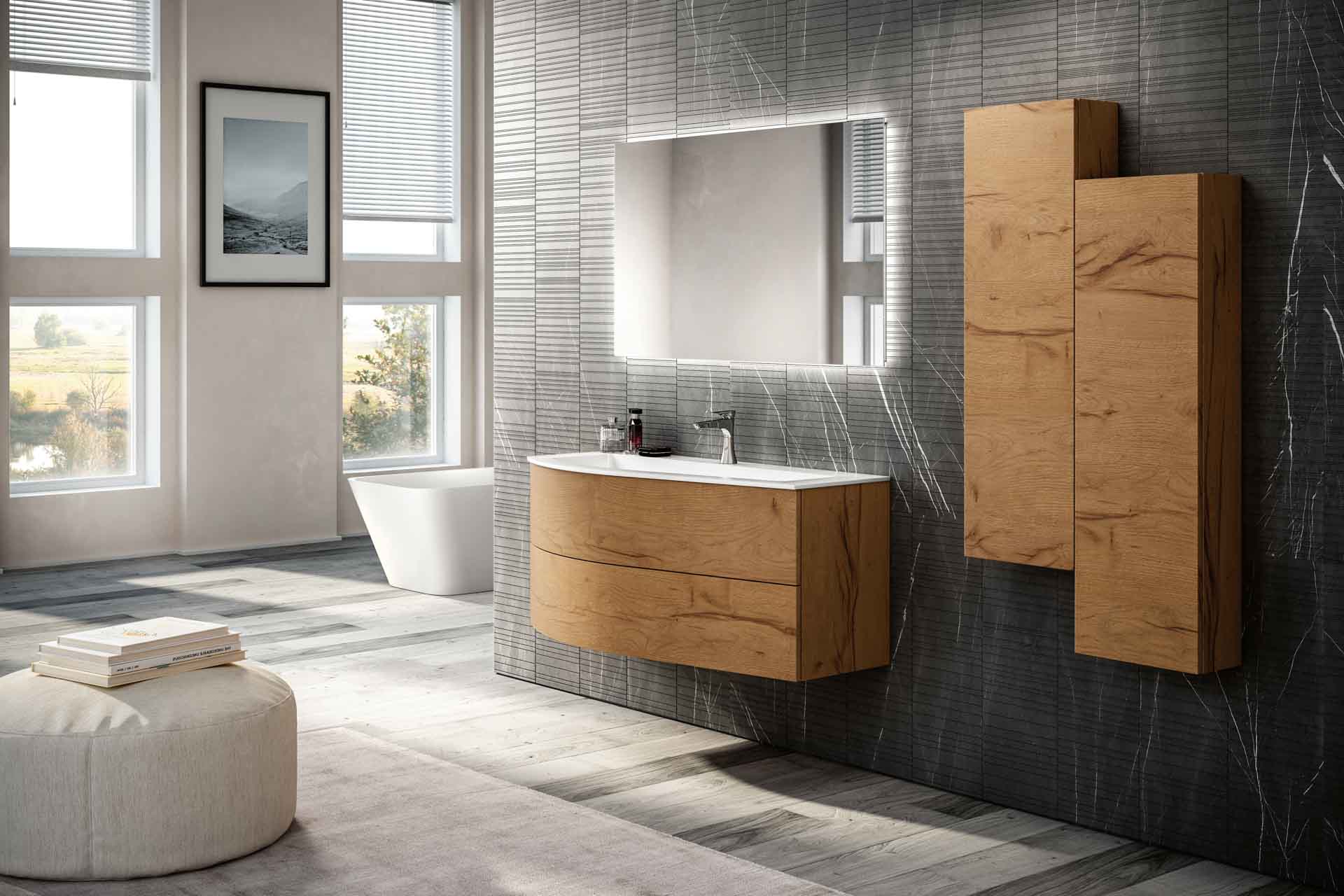
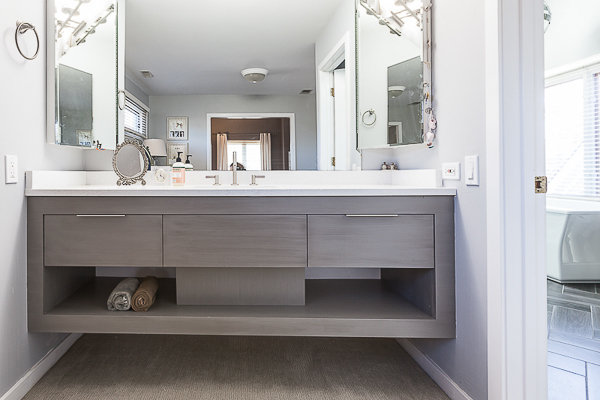
/fit-in/600x600/mall/file/2021/10/29/ff5cde19c4454aeeba3f343b2f9ef042.jpg)

/mall/file/2022/04/21/3f76591516d4bcada570ea056b999574.jpg)
/mall/file/2022/05/13/8b80845cad78a2166e133df8b663966e.jpg)
